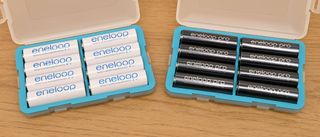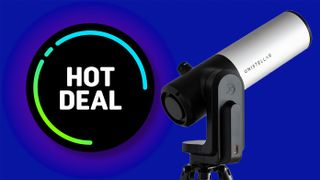Rechargeable batteries have been available for years, as a viable alternative to alkaline cells that typify the ‘throwaway culture’. But they haven’t been without their problems. Nicad (Nickel Cadmium) batteries were invented all the way back in 1899 and were still popular in the 1990s but they suffered from the dreaded ‘memory effect’, so you’d typically need to discharge them completely before recharging them. Cadmium is also toxic, and its use was banned in many world regions in the early 2000s.
Since the 1990s, NiMH (Nickel-Metal Hydride) batteries have been a much more popular choice for popular battery sizes like AA. They don’t suffer from a memory effect and enable higher electrical capacities, so last for longer between charges. Even so, early versions and many that are still available today tend to discharge over a few weeks after being fully charged, even if they’re just sat in a box doing nothing. That can be really frustrating if you go to use them, only to find they’ve gone flat.
• We also have a guide to the best AAA rechargeable batteries
The latest double-A NiMH batteries are engineered to hold most of their charge for many months or even years, making them a much more viable proposition for use in all sorts of household items from flashlights to remote controllers and pretty much anything that runs on batteries.
For photographers, an ideal use for rechargeable AA batteries is in flashguns. A further advantage is that most flashguns tend to recycle much faster after a high-power flash when using rechargeable NiMH batteries rather than regular alkaline cells. In our tests, we’ve found that some flashguns that take around 5 seconds to recycle after a full-power flash with fresh alkaline cells only take about 2 seconds with Ni-MH batteries.
So without further ado, lets take a look at some of the best rechargeable AA batteries on the market right now…
Best rechargeable AA batteries in 2023
Why you can trust Digital Camera World
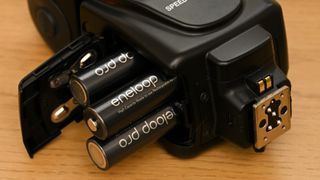
For photographers using batteries in their flashguns and anyone who needs to be able to trust their kit in critical situations, reliability is a key factor. At Digital Camera World, we’ve been using Eneloop Pro batteries for years and have enjoyed 100 per cent reliability, even in the harshest conditions. Indeed, the batteries are rated to work in temperatures from -20 to +50° C (-4° to 122° F).
As with most recent NiMH batteries, they come pre-charged (using solar power, no less) and are ready to use, straight out of the box. Compared with regular ENELOOP batteries, they have a higher capacity of 2500mAh compared with 1900mAh, outstripping alkaline batteries as well as many rechargeable options. They’re therefore ideally suited to power-hungry devices with a hefty current drain. The flipside is that the maximum number of times you can recharge the batteries over its lifetime is rated at 500, compared with 2100 times for regular Eneloop batteries.
See our full Eneloop Pro review
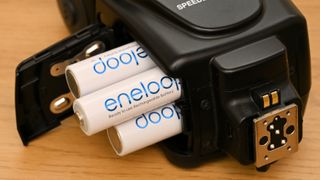
Eneloop batteries were among the first NiMH cells to hold their charge really well over a long period of time. The latest generation takes things to a whole new level, retaining 70 per cent of a full charge even after 10 years. The 2000mAh capacity doesn’t compare too favorably with many of the more high-capacity batteries on the market now but, for use in many devices including cameras and flashguns, they still last much longer than alkaline batteries before needing to be recharged.
Another major plus point is that you can recharge these Eneloop batteries a whopping 2100 times, so the overall lifetime far exceeds that of many competitors. As with the slightly pricier and higher-capacity Eneloop Pro batteries, they come pre-charged using solar power, are rated to work in a -20 to +50 degrees Celsius (-4° to 122° Fahrenheit) temperature range, and are designed and manufactured in Japan.
See our full Panasonic Eneloop Pro review

These batteries effectively give you the best of both worlds. They have a particularly high capacity of 2800mAh, coupled with a generous overall lifetime of up to 1200 recharging cycles. Suffice it to say you should be able to use them for many years. Made in China, they come pre-charged using wind-power, so they’re eco-friendly from the word go.
Maximum capacity is achieved after a couple of discharge/charge cycles and the batteries hold their charge very well, rated at retaining 60 per cent of a full charge after 2 years. Performance is guaranteed down to just below freezing temperatures. The batteries are widely available around the world and, in some regions, a ‘PRO Goldtop’ version is available with new conduction technology, although it has the same capacity and total number of recharges rating. Both editions are standout value at the price.
See our full Powerowl Pro Goldtop battery review
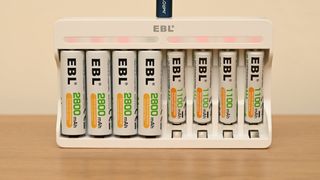
Established in 1998, EBL has earned a good reputation over the years, for making high-quality rechargeable batteries and chargers. There are various capacity options in their AA line-up but the 2800mAh is currently the most powerful. As such, it matches the likes of Eneloop Pro and Powerowl's range-topping AA batteries for capacity. The EBL batteries have a rated working temperature range of -20 degrees to +60 degrees Celsius, or -4 to 140 degrees Fahrenheit, so they’ll keep going in extreme environments.
The batteries have a steel shell and are designed to resist over-pressure, to ensure they’re leak-free. They also include over-charge, over-discharge, over-voltage and short-circuit protection. 4-packs and 8-packs of the batteries come complete with storage cases but, stated as a ‘safety feature’ they’re only 20% charged before being shipped, so you need to fully charge them before first use. The total number of times you can recharge them over their lifetime is rated at 1200, easing ahead of the 500 times for ENELOOP PRO.
See our full EBL rechargeable battery review

We love the option of combining these batteries with others. HiQuick sells these 2800mAh AA batteries in several different combinations, mixing and matching with 1100mAh AAA rechargeable NiMH batteries and different chargers, with or without a USB charging, and in different sizes for charging anything from two to twelve batteries at once.
We tested them in a variety of high-drain devices including flashlights and camera flashguns. We really liked their impressive staying power and complete reliability. As with various competitors, they stay charged for long periods when not in use, which is a must for us. All in all, they’re a top power-up and great value at a very competitive selling price.
Read more: HiQuick AAA Rechargeable 1100mAh review
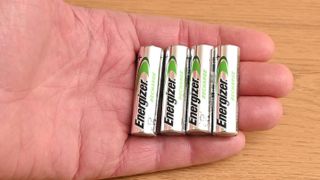
This battery comes from a trusted brand you’ll doubtless know. It has particularly good edo credentials, being the first rechargeable battery to be made with 15% recycled materials, including 4% recycled batteries. It’s sold in 100% recyclable packaging too, and should have a long life with up to 1000 recharge cycles.
The battery is rated at keeping its charge for a year and the 2000mAh capacity is good, if not entirely great. Energizer says that using the battery at extreme temperatures can significantly impact the battery cycle life, but it’s rated at 0 degrees to +50 degrees Celsius while in use, and -20 degrees to +30 degrees Celsius for storage. Unless you really need a higher-capacity battery for high devices with a big current drain, it’s a good value option at the price.
Read more: Energizer Recharge Power Plus AA review

Duracell certainly needs no introduction to anyone buying batteries, being one of the most famous brands in the world. The Duracell Rechargeable AA boasts an impressive capacity of 2500mAh, matching the Panasonic ENELOOP PRO and easing ahead of the standard ENELOOP AA by 25%. The Duracell only costs around 75% to buy, making it better value for money on the face of it.
Duracell doesn’t give a figure for how many times the battery can be recharged during its lifetime, saying only that it runs into the ‘hundreds’. On the plus side, the battery is guaranteed to last for 5 years, which should cover a lot of charge/discharge cycles. And naturally, being a Duracell battery, it comes complete with that iconic copper top.
Read more: Duracell Rechargeable AA review
How to choose the best rechargeable batteries
Why do rechargeable batteries seem to suddenly run out of power?
Alkaline batteries have a fairly constant discharge rate while in use. For example, if you’re using them in a flashgun, the recycle time between flashes will get steadily longer. NiMH batteries give a much more constant voltage throughout their discharge cycle, but it drops off rapidly at the end, when they run out of power.
Why does the charge indicator in devices not show full when I insert fresh rechargeable batteries?
When new, alkaline batteries have a potential difference across their electrodes of 1.5V (volts). NiMH batteries deliver a lower 1.2V even when fully charged, so devices that have an integral volt meter may display a lower reading.
Do I need to fully discharge NiMH batteries before recharging them?
Unlike older NiCad (Nickel Cadmium) rechargeable batteries, NiMH batteries don’t suffer from a ‘memory effect’, so there’s no need to fully discharge them before recharging.
What’s the best quantity in which to buy rechargeable batteries?
As with anything, it only pays to buy as many as you need. However, NiMH is an effective replacement for regular (non-rechargeable) alkaline AA batteries in most devices and, like most things, if you buy in larger quantities, there are often significant savings to be made.
What’s the best way of storing rechargeable batteries when I’m not using them?
Ideally, store them in a cool, dry place. Theoretically, the colder the better, but it’s best not to store them in a refrigerator to avoid the risk of condensation when you take them out for use.
Can I use any charging device for my rechargeable batteries?
Most battery manufacturers only recommend using own-brand rechargers – and you can usually buy the charger and your AA cells in a kit. Independently manufactured rechargers should be ok but it’s best to avoid very ‘fast chargers’, as these can shorten the lifespan of the battery and can cause problems from the batteries overheating and even leaking. Overcharging can damage or destroy a battery.
